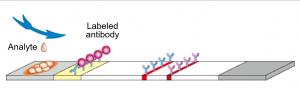Fingerprint recognition is one of the biometric techniques that compares and checks a person's identity using measurable physical and behavioral characteristics. Besides fingerprints, many biometric technologies can identify a face, retina, iris, or voice. Fingerprint recognition naturally springs to mind first when considering the technology that is most readily seen around us and commonly used. In fact, since the world's first murder case was resolved in 1892 using fingerprints, collecting and analyzing fingerprints has been used as one of the most important investigation methods. Fingerprints, which were primarily used only for scientific investigations, were advanced in the late 1960s with the development of a live scan system that allows electronic fingerprints to be recorded. This marked a turning point for the full-fledged development of fingerprint recognition technology. Since then, as related technology has continued to develop and advanced smart devices such as smartphones, laptops, and tablet PCs have been produced in earnest, fingerprint recognition is a commonly used everyday technology.
We would like to learn more about fingerprint recognition technology, which can be said to be the present and future of biometric technology.
First, to know about fingerprint recognition technology, you need to be able to know about fingerprints. Fingerprints refer to swirl-shaped lines at the fingertips of most primates, including humans. Fingerprints are said to have only a billionth possibility of having the same design of fingerprints as another person. This is because the sweat glands at the fingertips of the fetus are partially raised and do not change throughout their lives. If you look more closely, the fingerprint is largely divided into a ridge, the projecting part of the sweat glands, and a valley, the concave part between the ridges. Moreover, there is an end point at which the ridge breaks, a bifurcation point at the end of the ridge rotation, a core point at the end of the ridge rotation, and a delta at which the flow of the ridge is collected from three directions.
Fingerprint recognition technology starts by acquiring image information of fingerprints through fingerprint recognition sensors, to utilize the characteristics of these fingerprints. After extracting the image information of the fingerprint, various unique points such as the distance between ridges or bifurcation points and the distance between bifurcation points and end points. These are extracted based on the features of the fingerprint, converted into digital information, and stored in the database (DB). After that, when the user recognizes the fingerprint on the recognition sensor, it is compared with the feature information from the fingerprints formerly stored in the DB to find out whether it is the correct person or not.
It can be said that the most important thing in this fingerprint recognition technology is to acquire and extract fingerprint image information, that is, fingerprint samples, through a recognition sensor. This is because no matter how good other technologies are, if the fingerprint recognition sensor incorrectly acquires and extracts fingerprint samples, it will be worthless. Justly, technology related to fingerprint recognition sensors have developed constantly and in various ways. Currently, there are three main sensor methods: optical, capacitive, and ultrasonic methods, which distinguish them between the fingerprint recognition technology.
First, an optical sensor is a method of shooting light from a light source in a way similar to taking fingerprints with a camera or an optical scanner. If you put your finger on a glass plate equipped with a fingerprint sensor, a digital camera focusing on the outer surface of the glass plate takes black-and-white pictures. When taking a picture, the convex side of the fingerprint is pressed against the glass plate, so only the fingerprint is focused and the rest of the fingerprint is blurred, allowing the outline of the fingerprint to be extracted. Since the optical sensor is the simplest fingerprint recognition technology, they are the most common scanners being used to make resident registration cards or to manage entry/ exit points and for commuting. However, today when there are foreign substances such as water present on the hand, the fingerprint recognition is not good. Both the camera and the scanner are simply 2D fingerprinting, so it is gradually being replaced by other fingerprint recognition technology because of the disadvantage that it is can be deceived by Incorrect fingerprints.
Fingerprint recognition technology, which addresses some of the shortcomings of the optical method, is capacitive. Capacitive senses a voltage difference in the finger. If you look carefully, the fingerprint has an uneven surface because it is a combination of ridges and valleys, as mentioned earlier. Using these characteristics to generate a voltage reading, a human has a minute electrical current that flows in the human body, is then read by the fingerprint recognition sensor. The voltage in the area where the sensor and skin are connected is smaller than the voltage in the area where the sensor and skin are separated. The biggest advantage of the capacitive method is that it can prevent the acceptance of fake fingerprints, which was one of the disadvantages of the optical method. A microcurrent called bioelectricity flows through a living human body, but it obviously does not flow through pictures or fake fingerprints, and is therefore very secure. However, the disadvantage of fingerprints not being recognized well when foreign substances are on the hand remains the same. So, many studies were aimed at fingerprint recognition technology that removes all of the disadvantages of these 2 methods, while providing accurate readings and high security. Research and Development (R&D) has been made, and fingerprint recognition technology that satisfies these needs has eventually emerged.
The new fingerprint recognition technology is ultrasound. Ultrasound is a method of emitting sound waves instead of light, from a fingerprint recognition sensor, to measure the amount of time for the wave to return to the sensor, using it to identify the height differences of the fingerprint ridges and valleys and extract the fingerprint. In addition, the sound waves pass through the skin, so they can be recognized even if there is a foreign substance on the hand. Also blood flow can be analyzed by identifying blood vessels in the finger, preventing fake fingerprints. Besides these benefits, ultrasound also has a very fast recognition speed compared to the optical method, and sound waves can penetrate through a solid medium such as glass. This means you can implement on-screen fingerprint recognition by placing a fingerprint sensor under the screen of a smart device such as a smartphone.
Despite the many advantages of this technology, it can be presumed that ultrasound has not yet become more popular because of the cost for the expensive equipment, which is why companies are reluctant to adopt this method. But, if technology advances soon and the price of parts is reduced, all existing fingerprint recognition methods are predicted to be changed to the ultrasound method.
What will happen to the future of fingerprint recognition, which has many advantages and is being used in various fields around the world? Of course, I think it can continue to be used in many areas as it is now, but there are some concerns. Among them, the most serious problem is that despite the rapid advancement of fingerprint recognition technology, there are still risks involved through pictures and fake fingerprints. In theory, both capacitive and ultrasound are safe from security threats, but they are still capable of being penetrated. If they are penetrated, they can be exposed to be used in various crimes such as cybercriminals seeking information. Therefore, continuous research is needed for fingerprint recognition to continue to be a valuable security function in the future. I think it is important to improve security through R&D and at the same time reinforce convenience for users to make it more handy and secure.
Choi Yongha kubabiba7613@naver.com
<저작권자 © 홍익대영자신문사, 무단 전재 및 재배포 금지>





